This match promised to be one of the best ones of this year’s campaign of the 2. Bundesliga. The two only unbeaten teams Arminia Bielefeld and VfB Stuttgart would meet each other on the eighth matchday. The team of Tim Walter was ahead of this game in the first place with five wins and two ties while on the other hand, Bielefeld managed to get four wins out of the opening seven games.
In a thrilling contest, Stuttgart was able to win the game due to the only goal in this game which has been scored two minutes before the referee blew his whistle to end this match. This tactical analysis will look at the tactics which both teams applied and will show why this game was so evenly matched.
Lineups
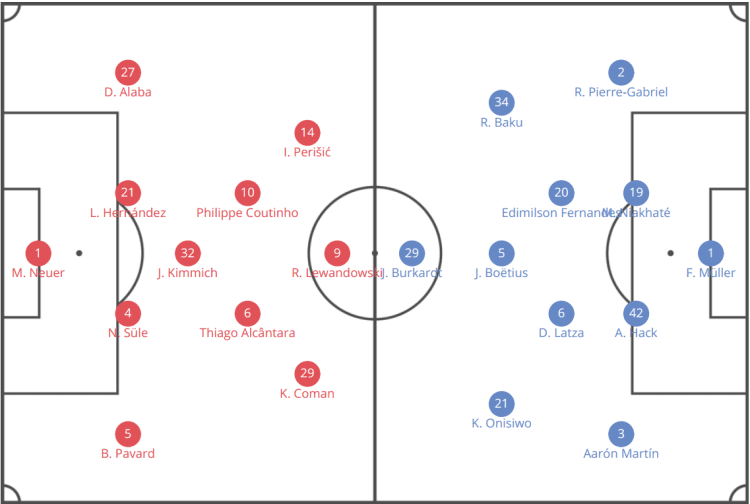
Bielefeld’s coach Uwe Neuhaus lined his team in a 4-4-2 formation up with a partnership of Jóan Símun Edmundsson and captain Fabian Klos. The midfield for behind them was made of Andreas Voglsammer, Marcel Hartel, Manuel Prietl and Cebio Soukou.
The back four consisted of Florian Hartherz, Joakim Nilsson, Amos Pieper and Cédric Brunner who returned from injury. Stefan Ortega was between the sticks.
On the other side, Stuttgart used a 4-3-3 formation which was incredibly flexible as we know it from teams of their coach Walter and as we will see later in this analysis.
The Swiss Gregor Kobel was the goalkeeper of Stuttgart and as usual Holger Badstuber and Marc Oliver Kempf played in the central defence. Emiliano Insúa and Pascal Stenzel were the full-backs.
The central man in front of the back four was Atakan Karazor and the two likes of Orel Mangala and Santiago Ascacíbar supported him in the midfield. The Argentinian Ascacíbar made his return since he missed the last games because they took him out of the squad due to disciplinary reason.
Daniel Didavi and Philipp Förster were the wingers even though both men are usually offensive central midfielders. Hamadi Al Ghaddioui was the only striker and the only one who scored in this match.
The opening minutes
Right from kick-off Stuttgart tried to put pressure on their opponents as soon as possible. Their goal was to avoid that Bielefeld could have an organized build-up with short passes. In light of this, Walter’s team used a very high pressing to don’t give their opponents a chance to play out from the back with short passes.
The two central-backs and the central midfielder Prietl were responsible for Bielefeld’s build-up and also got supported by their goalkeeper Ortega. With the aid of cover shadows, Stuttgart’s front three were able to create numerical equality. As shown in the example below where Didavi and Förster are near their opponents while Al Ghaddioui uses his cover shadow to cut off the passing option to Nilsson who is currently not in the image.
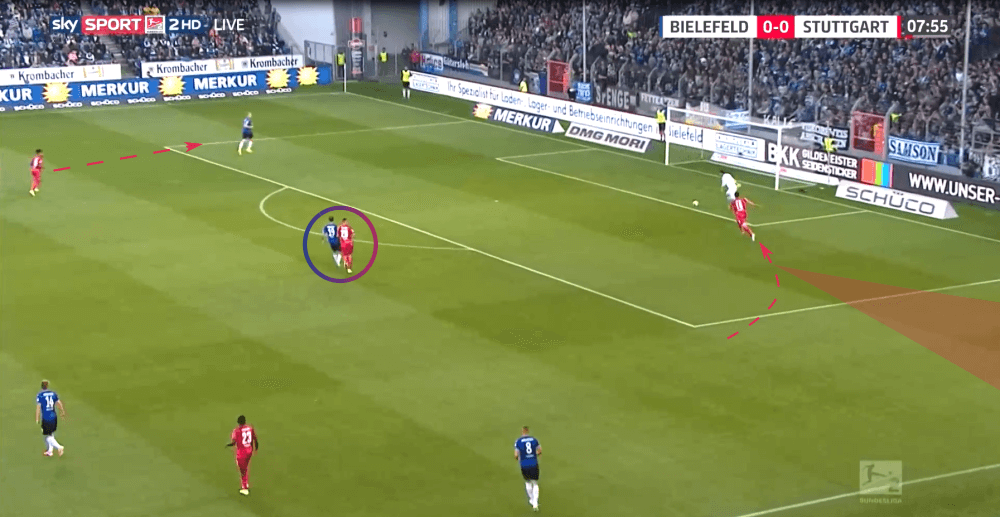
On the other side, Bielefeld’s goal in the opening minutes was to show their opponents why they were in the third position ahead of this match. They played very brave and pressed in at Walter’s team incredibly high on the pitch. As shown in the image below they often tried to man-mark their opponents. However, due to the rotations and positional changes which the Schwaben used during the build-up to create spaces and passing lanes the players of Bielefeld didn’t just follow one specific player but worked together.
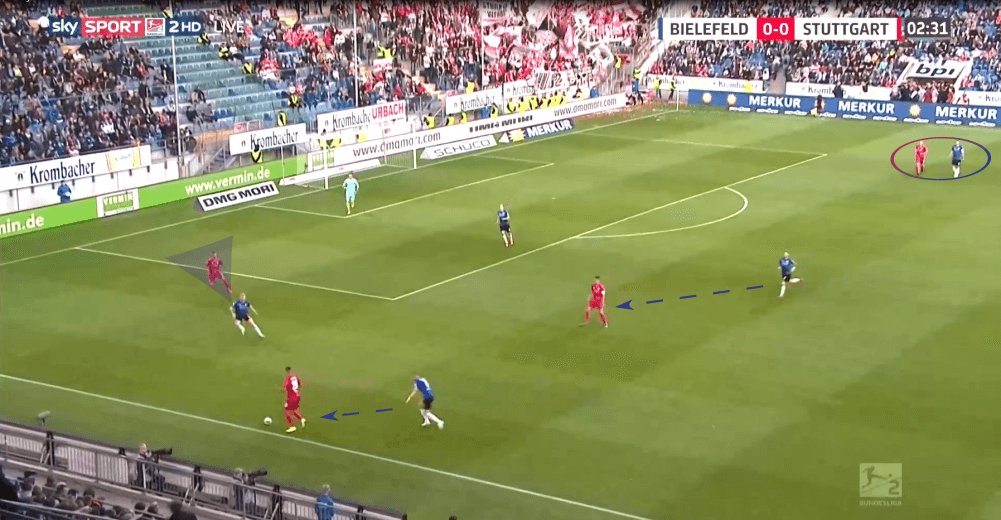
Even though the high and intense pressing of Neuhaus’ team was executed well, Stuttgart’s players were almost in every situation able to find a short passing option to solve the situation. They also often included the goalkeeper Nübel to create numerical superiority. When the opponent press in so aggressive and high up the pitch, it’s vital to have a goalkeeper who is strong with his feet as the Swiss is.
In the first 15 minutes of the game, Stuttgart had a success rate of passes of incredible 94.44%. This is a stat which perfectly showcases their technical ability and pressing resistance. In the image below, for example, the right-back Stenzel has no passing option since Bielefeld once more cuts off all passing options. Most of the players play a long ball in this situation, but the German just fakes this long pass, turns inside and passes to Nübel who can then play to the other side solve the situation.
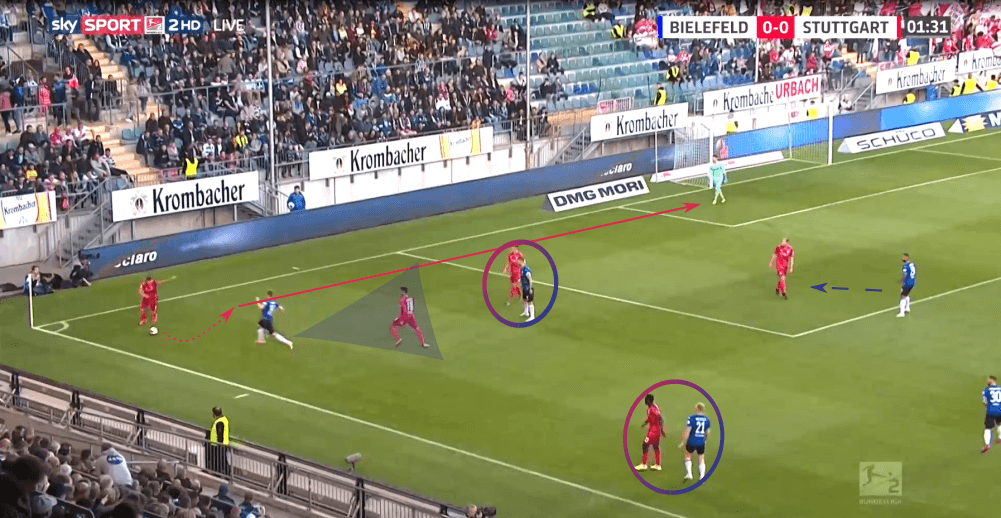
In the opening minutes, both teams tried to press in at their opponents very high up the pitch. However, the Schwaben were able to solve these situations with short passing combinations while Bielefeld had their problems. After a bit less than 15 minutes, Stuttgart gained control of the match as we will see now in this analysis.
Stuttgart’s flexibility
Walter is one of the most exciting coaches in Germany at the moment. His team plays a very unique style of football and until now they are extremely successful with it as the statistics of this season show. After eight games they are in the first position with 20 points.
Their rotations and positional changes when they are in possession are incredible to watch since it’s extremely rare that a team is that flexible. In this game, they mainly tried to build up the attacks with a back three which consisted of the right-back Stenzel and the two centre-backs Badstuber and Kempf. However, they used different structures and positions respectively. In one moment Stenzel was the right part of the back three, Badstuber in the centre and Kempf on the left side. In the next situation, the right-back was in the centre and Kempf switched the side. This gets visible in the image below.
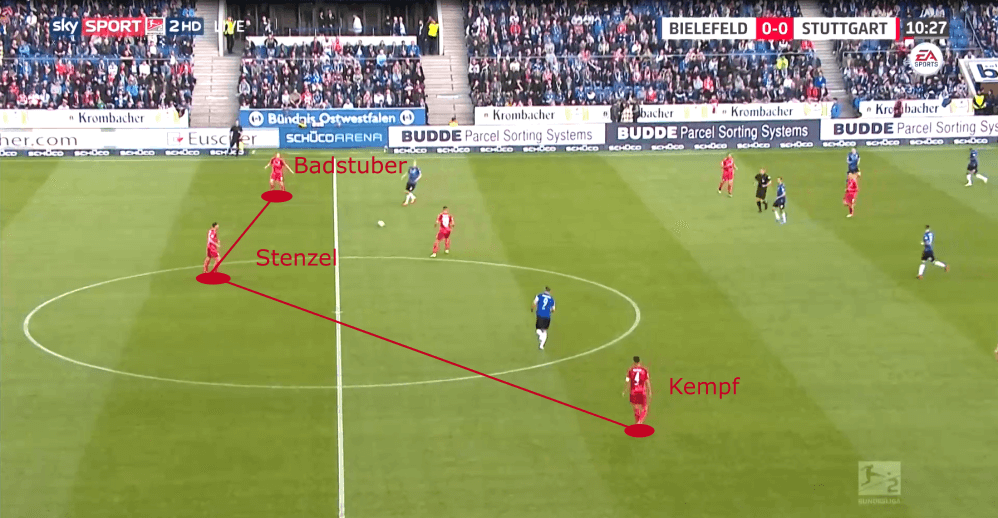
But not just the back three during the build-up often changed their positions. The whole team always used rotations and interesting movements to open up passing lanes to progress the ball further up the pitch. As shown in the example below, the players left their usual position on several occasions. These movements make it very hard for the opposition to defend against Stuttgart since the players are permanently forced to decide if they should stay in their position or follow their opponent.
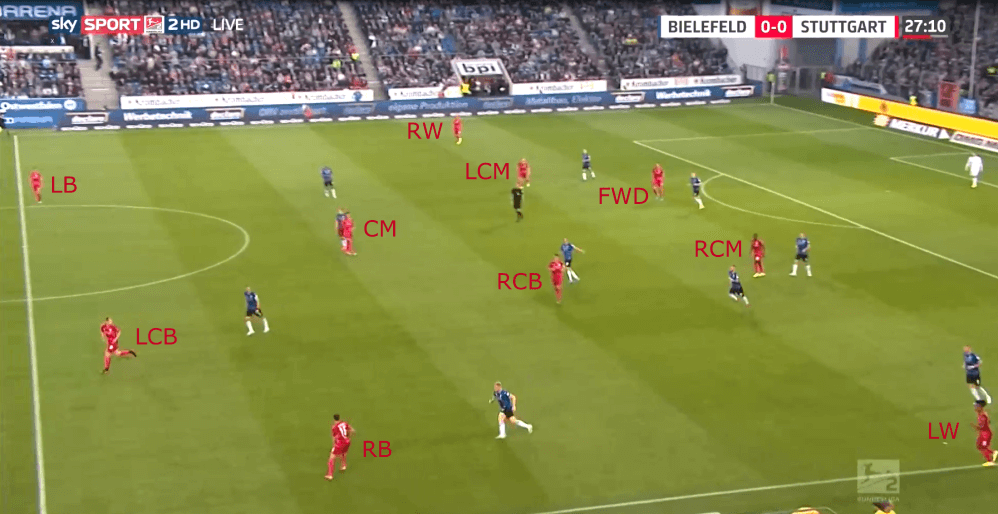
The position of the right central midfielder Mangala was also very interesting to watch. Due to the fact that the right-winger Förster is usually a central offensive midfielder, he often shifted inside into the half-space and didn’t permanently stay wide near the touchline. The same movement showed Didavi when the two wingers changed the sides. To open up the passing lane from the back three to Förster or Didavi, Mangala often dropped out into the wide-area to pin one opponent. Because of that, the German right-winger had more space in the half-space to receive the ball.
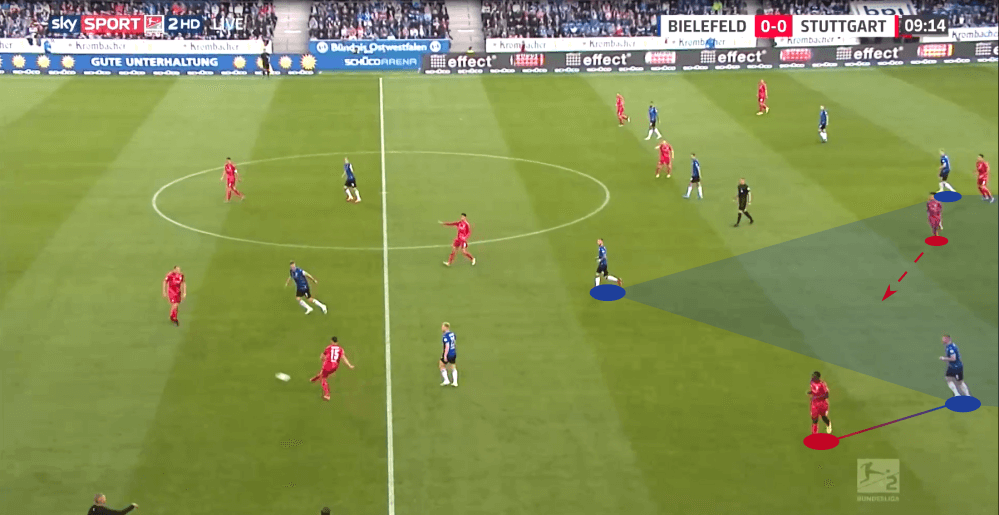
Stuttgart’s defenders aren’t the fastest and in addition, they are always positioned very high during the build-up and their own attacks. Due to that, counter-attacks can really hurt them. In the game against Bielefeld, they once more used an aggressive counter-pressing to stop these transition moments. Because of the well-executed counter-pressing and their dominant style of play Stuttgart had at the end of the match 65.74% possession. As shown in the example below, they immediately put pressure on their opponents to win it back. Due to that, Bielfeld had no real counter-attack during the whole game.
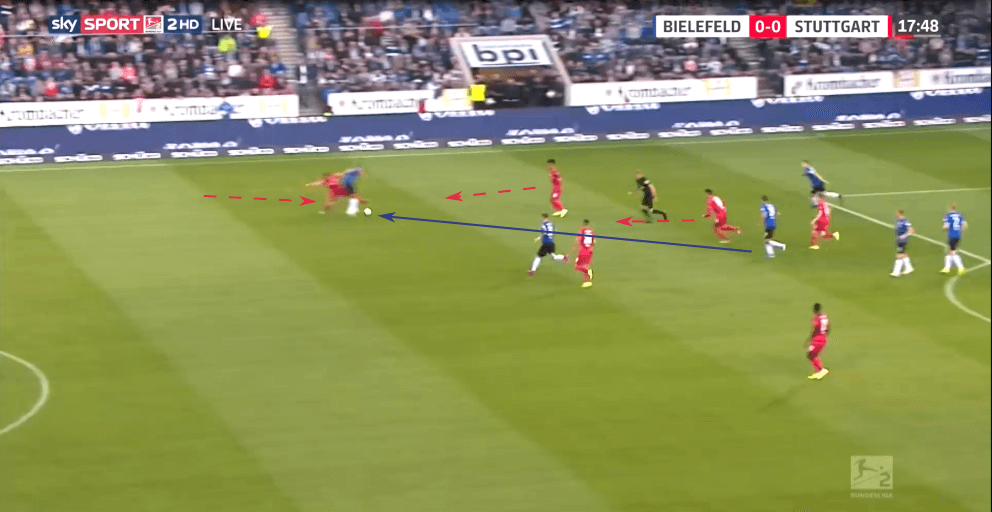
Bielefeld’s plan
After the opening phase of the match, Neuhaus’ team didn’t only use a high pressing. They still tried on some occasion to put pressure on Stuttgart’s players very high up the pitch, but it is physically not possible to execute such a pressing over 90 minutes.
In light of this, they switched between different concepts and tactics respectively. They either pressed in at Stuttgart as they did in the opening minutes and as already shown in this analysis or sat back and defended in a narrow 4-4-2. In these situations, they tried to keep the distance between the single players as well as the space between the two banks of four as small as possible.
They didn’t just sit back but often put pressure on their opponents at about the halfway line and so Stuttgart had real problems to break them down. Even though the team of Walter dominated the game and had 65.74% possession, they just shot four times on the goal of the goalkeeper Ortega. Bielefeld varied their pressing height but always stayed in their 4-4-2 as shown in the image below.
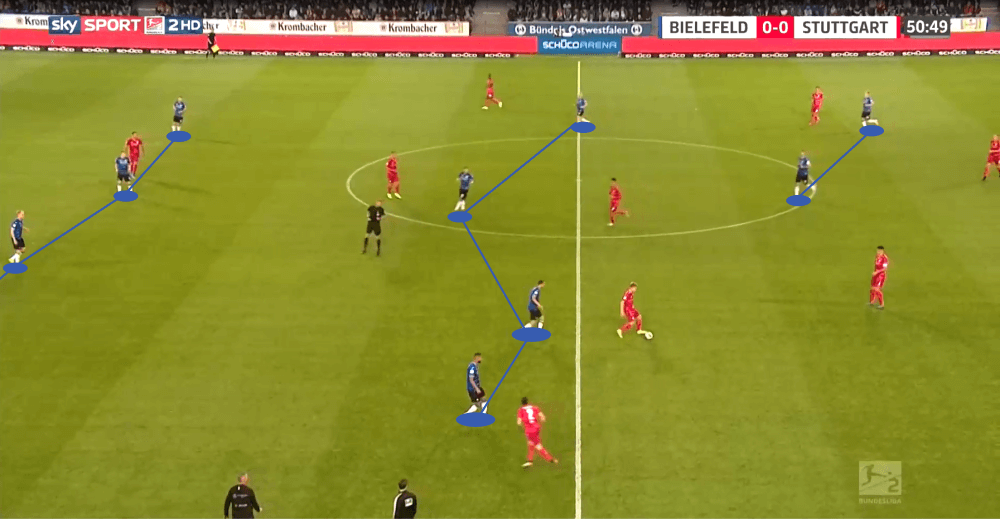
On the other side, Bielefeld wanted to have a build-up with short passes to progress the ball. However, over long periods of the game, this was almost impossible due to the high pressing of Stuttgart who always tried to create at least numerical equality in the space around the ball. Due to that, it was hard for the players of Neuhaus to play short passes and so they couldn’t have the organized build-up which they would have wanted to have. In the image below we can see a typical situation in which Stuttgart is even able to create numerical superiority near the ball.
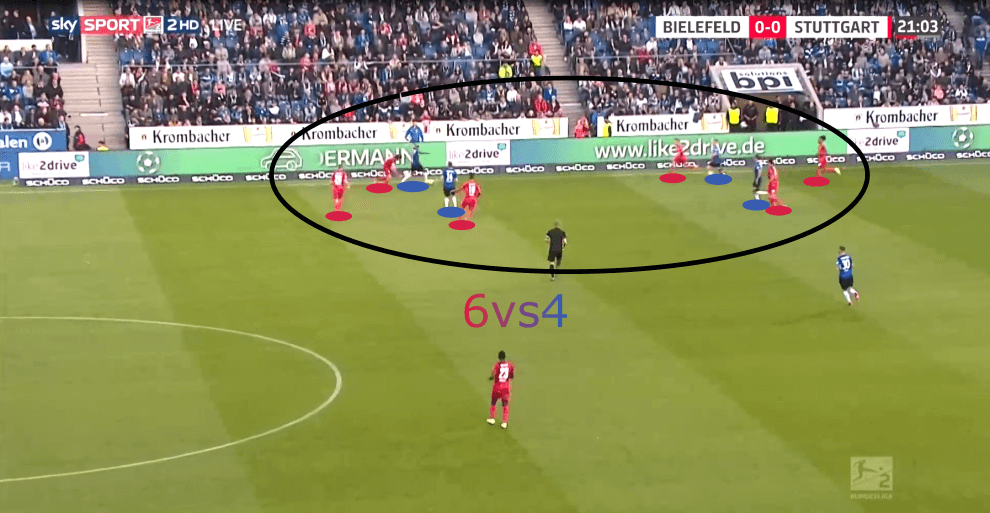
Besides, the front three of Walter’s squad already positioned themselves very high ahead of the goal kicks of Bielefeld’s goalkeeper. This clearly showed the intention of Stuttgart as they wanted to stop the build-up of their opponents as soon as possible. They were very successful to do so what the stat proves that Bielefeld played on average just 2.95 passes per period of possession. On the other hand, Stuttgart had a value of 5.82.
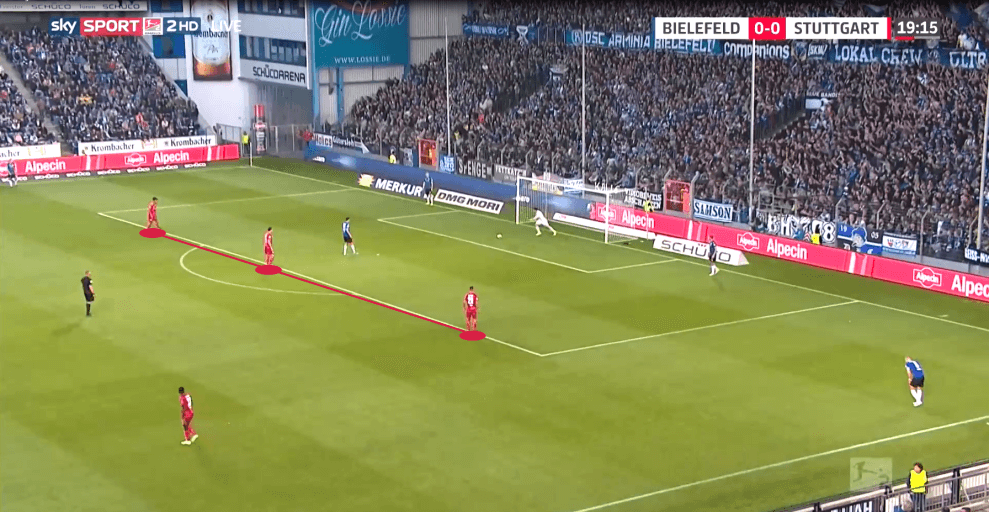
Because of the great pressing and counter-pressing of Walter’s team, Bielefeld often had no other choice but to play a long ball. The target of these long passes was usually their striker and captain Klos. The German striker was involved in 11 aerial duels during his 61 minutes on the pitch since then he earned a second yellow card and got sent off. They wanted to have at least two men near Klos to win the second ball after the aerial duel. However, this worked quite well in some situations when the German was able to lay off the ball for his teammates but in the end, Stuttgart mostly defended too well and so Neuhaus’ just shot two times on the goal of Nübel.
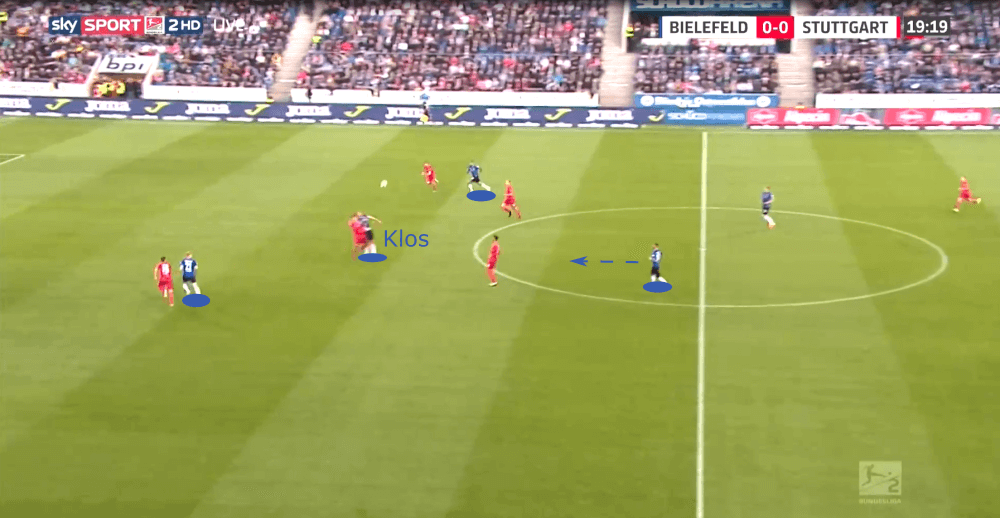
The presumed turning point
As the stat that Klos was involved in 11 aerial duels in 61 minutes proves, he was very important for his team. However, during such an aerial duel in the 61st minute, he hit his opponent with the elbow and due to that, the referee showed him his second yellow card. This seemed to be the turning point of this game since then Stuttgart dominated but never were really able to create dangerous goalscoring chances. In light of this, all people thought that now they would have more space and the numerical advantage would help them to score at least once.
However, Bielefeld switched from a 4-4-2 to a 4-4-1 and just Edmundsson was then upfront as the single striker. The two banks of four continued to be very disciplined while defending and made it incredibly hard for the opposition to break them down. In the image below we can see their formation after Klos got sent off.
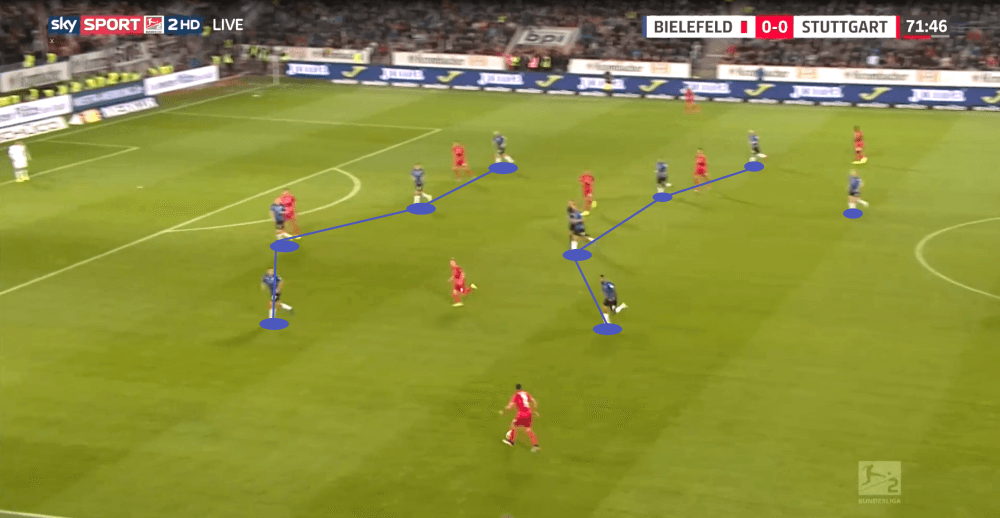
And as it seemed as Bielefeld would be able to get one point and remain unbeaten, Stuttgart’s striker Al Ghaddioui managed to score his goal in the 91st minute to get the victory. Ahead of this goal, the right-back Stenzel who mostly stayed deeper during the build-up as already shown in this analysis positioned himself on the right-wing. Considering this, Bielefeld’s left-back Hartherz orientated at him and because of that the distance between Bielefeld’s left-back and centre-back. Kempf spotted this and found Förster with a great through pass who laid the ball off for Al Ghaddioui who then scored the 1-0 in the 91st minute.
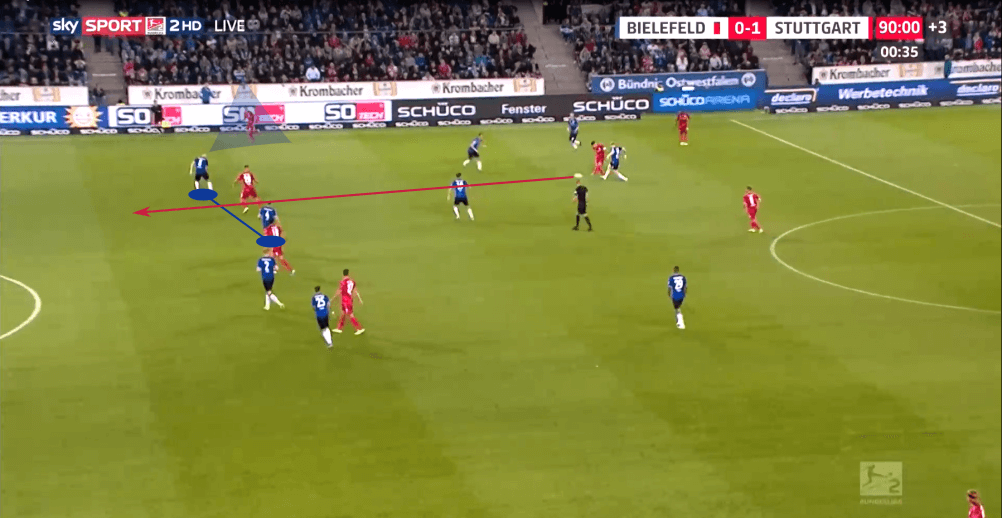
Conclusion
Bielefeld showed a great team performance and made it extremely hard for Stuttgart to create goalscoring chances. It’s uncertain if the game would have ended another way if the referee wouldn’t have sent off Klos.
All in all, Stuttgart probably deserved the win a bit more since they also played well and executed a great pressing and counter-pressing. If they can continue their great form, the promotion to the highest German division seems to be realistic. However, even after this loss, Bielefeld stays in the great third position. Stuttgart will face Wiesbaden next week while Neuhaus’ team plays against Osnabrück away from home and it wouldn’t be a surprise if both teams can win their game.

If you love tactical analysis, then you’ll love the digital magazines from totalfootballanalysis.com – a guaranteed 100+ pages of pure tactical analysis covering topics from the Premier League, Serie A, La Liga, Bundesliga and many, many more. Buy your copy of the September issue for just ₤4.99 here




Comments